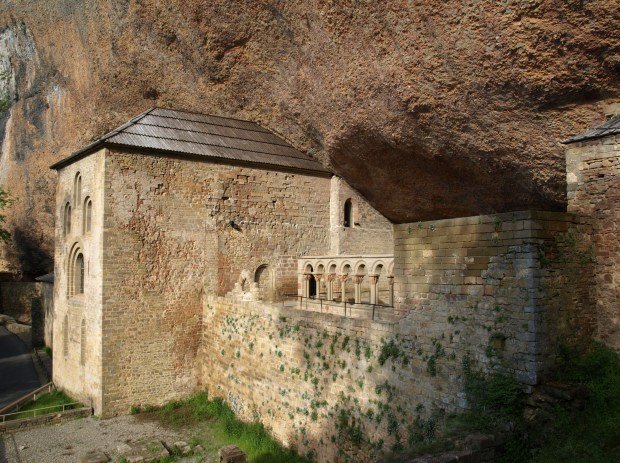Lenten Campaign 2025
This content is free of charge, as are all our articles.
Support us with a donation that is tax-deductible and enable us to continue to reach millions of readers.
In the quiet town of Santa Cruz de la Serós (Spain) lies the Monastery of San Juan de la Peña. Known as one of the most important monasteries in medieval Aragon, this historic religious complex attracts travelers from all walks of life with its intriguing heritage, spiritual significance, and legendary stories.
Carved into the imposing cliff that overlooks its foundation, the monastery’s name is aptly translated as St. John of the Cliff.
The monastery’s two-story church features architectural elements that reflect a blend of Mozarabic and Romanesque styles: while the lower church retains some of its original Mozarabic features, the more prominent sections (including the magnificent cloister) are magnificent examples of classic Iberian Romanesque architecture. Built around 1190, the cloister features intricately carved capitals depicting biblical scenes, originally arranged in a chronological narrative -- a distinctive design found in the region.
It was also the first monastery in Spain to celebrate the Latin Mass.

In 1675, a devastating fire led to the construction of a new monastery. However, the original monastery, founded in 920, holds a prestigious status and was declared a National Monument on July 13, 1889. The newer structure received similar recognition in 1923.
The monastery’s unique location under a massive rock certainly adds to its aura. The second floor houses a royal pantheon: it is the final resting place of several kings of Aragon and Navarre.
The Pantheon, decorated with marble and stucco medallions depicting historical battles, was largely designed during the reign of Charles III of Spain in 1770. Here lie the remains of three kings -- Ramiro I, Sancho Ramírez, and Peter I of Aragon and Navarre.
La Peña and the Holy Grail
Legend has it that the chalice used at the Last Supper, the Holy Grail, was hidden in the monastery to protect it from Muslim invaders during the tumultuous periods of Iberian history. This holy relic is believed to be the same chalice that Alfonso V of Aragon gave to the Valencia Cathedral in 1438. According to tradition, the Holy Grail was brought to Spain by St. Lawrence, a Spanish-born deacon martyred in Rome in 258 AD.
Fearing the Grail's capture, Lawrence sent the chalice to his homeland for safekeeping. It journeyed through various hands and locations before finally being enshrined in San Juan de la Peña -- thus adding yet another layer of spiritual and historical significance to the monastery.
The monastery also lends its name to the Chronicle of San Juan de la Peña, a historical record that was partially researched and written in its hallowed halls: It was the first general history of Aragon and was probably intended to compete with the comparable Castilian work of a century earlier, the Estoria de España. Navarro-Aragonese and Catalan translations of these chronicles were made between 1369 and 1372.
For Catholic pilgrims and history buffs alike, San Juan de la Peña offers a unique and memorable journey into Spain’s spiritual and cultural past.










